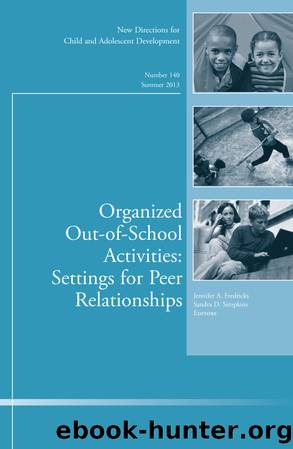Organized Out-Of-School Activities: Setting for Peer Relationships by Fredricks Jennifer A.;Simpkins Sandra D.; & Sandra D. Simpkins

Author:Fredricks, Jennifer A.;Simpkins, Sandra D.; & Sandra D. Simpkins
Language: eng
Format: epub
Publisher: John Wiley & Sons, Incorporated
Published: 2013-06-18T00:00:00+00:00
References
Aiken, L. S., & West, S. G. (1991). Multiple regression: Testing and interpreting interactions. Newbury Park, CA: Sage Publications.
Ajzen, I., & Driver, B. L. (1992). Application of the theory of planned behavior to leisure choice. Journal of Leisure Research, 24, 207â224. Retrieved from http://pl8cg5fc8w.scholar.serialssolutions.com/?sid=google&auinit=I&aulast=Ajzen&atitle=Application+of+the+theory+of+planned+behavior+to+leisure+choice.&title=Journal+of+leisure+research&date=1992&issn=0022â2216
Allen, J. P., Porter, M. R., McFarland, F. C., Marsh, P., & McElhaney, K. B. (2005). The two faces of adolescents' success with peers: Adolescent popularity, social adaptation, and deviant behavior. Child Development, 76, 747â760.
Bandura, A. (1989). Human agency in social cognitive theory. American Psychologist, 44, 1175â1184. doi:10.1037//0003â066X.44.9.1175
Barnes, G. M., Hoffman, J. H., Welte, J. W., Farrell, M. P., & Dintcheff, B. A. (2007). Adolescents' time use: Effects on substance use, delinquency, and sexual activity. Journal of Youth and Adolescence, 36, 697â710. doi:10.1007/s10964â006â9075â0
Becker, B. E., & Luthar, S. S. (2007). Peer-perceived admiration and social preference: Contextual correlates of positive peer regard among suburban and urban adolescents. Journal of Research on Adolescence, 17, 117â144.
Bohnert, A., Fredricks, J., & Randall, E. (2010). Unique dimensions of youth organized activity involvement: Theoretical and methodological considerations. Review of Educational Research, 80, 576â610. doi:10.3102/0034654310364533
Brown, B. B., Bakken, J. P., Ameringer, S. W., & Mahon, S. D. (2008). A comprehensive conceptualization of the peer influence process in adolescence. In M. J. Prinstein & K. A. Dodge (Eds.), Understanding peer influence in children and adolescents (pp. 17â44). New York, NY: Guilford Press.
Brown, B. B., & Larson, J. (2009). Peer relationships in adolescence. In R. M. Lerner & L. Steinberg (Eds.), The handbook of adolescent psychology: Vol. 2. Contextual influences on adolescent development (3rd ed., pp. 74â103). Hoboken, NJ: Wiley.
Brown, B. L., & Martin, M. (1999). African American female basketball players: An examination of alcohol and drug behaviors. College Health, 48, 129â133. doi:10.1080/07448489909595684
Cohen, E. S., & Fromme, K. (2002). Differential determinants of young adult substance use and high-risk sexual behavior. Journal of Applied Social Psychology, 32, 1124â1150.
Compas, B. E., Connor-Smith, M., Saltzman, H., Thomsen, A. H., & Wadsworth, M. E. (2001). Coping with stress during childhood and adolescence: Progress, problems, and potential in theory and research. Psychological Bulletin, 127, 87â127. doi:10.1037//0033â2909.127.1.87
Darling, N., Caldwell, L. L., & Smith, R. (2005). Participation in school-based extracurricular activities and adolescent adjustment. Journal of Leisure Research, 37, 51â76. Retrieved from http://vnweb.hwwilsonweb.com.ezproxy1.lib.asu.edu/hww/results/results_single_fulltext.jhtml;hwwilsonid=FPRVENN0VX03LQA3DIKSFGOADUNGIIV0
Diego, M., Field, T., & Sanders, C. (2003). Academic performance, popularity, and depression predictor adolescent substance use. Adolescence, 38, 35â42. Retrieved from http://web.ebscohost.com.ezproxy1.lib.asu.edu/ehost/detail?vid=2&hid=21&sid=829f8603â3826â4c59-b6dc-49d905cbcac9%40sessionmgr14&bdata=JnNpdGU9ZWhvc3QtbGl2ZQ%3d%3d#db=aph&AN=9993489
Eccles, J. S., & Barber, B. (1999). Student council, volunteering, basketball, or marching band: What kind of extracurricular participation matters? Journal of Adolescent Research, 14, 10â43. doi:10.1177/0743558499141003
Farb, A. M., & Matjasko, J. L. (2012). Recent advances in research on school-based extracurricular activities and adolescent development. Developmental Review, 32, 1â48.
Fauth, R. C., Roth, J. L., & Brooks-Gunn, J. (2007). Does the neighborhood context alter the link between youth's after-school time activities and developmental outcomes? A multilevel analysis. Developmental Psychology, 43, 760â777. doi:10.1037/0012â1649.43.3.760
Gardner, M., Roth, J., & Brooks-Gunn, J. (2009). Sports participation and juvenile delinquency: The role of the peer context among adolescent boys and girls with varied histories of problem behavior.
Download
This site does not store any files on its server. We only index and link to content provided by other sites. Please contact the content providers to delete copyright contents if any and email us, we'll remove relevant links or contents immediately.
| Alphabet | Body |
| Colors | Counting |
| Opposites | Seasons |
| Sense & Sensation | Size & Shape |
| Sounds | Time |
| Words |
One Fish Two Fish Red Fish Blue Fish by Dr Seuss(2273)
The Cat in the Hat by Dr. Seuss(2059)
The Peter Rabbit Stories by Potter Beatrix(2009)
The Very Hungry Caterpillar by Eric Carle(1533)
The Berenstain Bears and the Spooky Old Tree by Stan Berenstain(1189)
Green Eggs and Ham (I Can Read It All by Myself) by Dr. Seuss(1175)
Hurry! Hurry! by Eve Bunting(1121)
Ollie's Halloween by Olivier Dunrea(1118)
The Tale of Johnny Town-Mouse by Beatrix Potter(1102)
Hop on Pop by Dr. Seuss(1101)
Flap Your Wings by P.D. Eastman(1060)
Old Hat New Hat by Stan Berenstain(1054)
Story of a Fierce Bad Rabbit by Beatrix Potter(1042)
10 Hungry Rabbits by Anita Lobel(1036)
A Camping Spree with Mr. Magee by Chris Van Dusen(1031)
One Fish Two Fish Red Fish Blue Fish by Seuss(1013)
Forever or a Day by Sarah Jacoby(1000)
Beatrix Potter by The Tale of Two Bad Mice(994)
The House that Jack Built by Books Golden(981)
